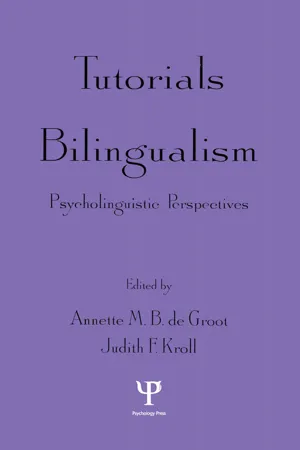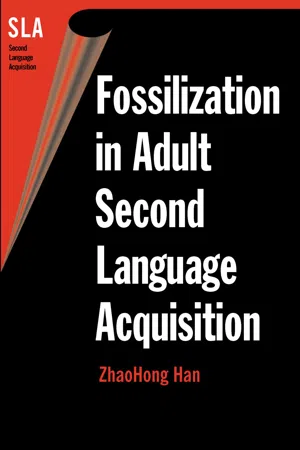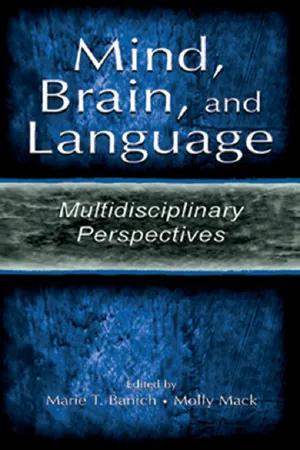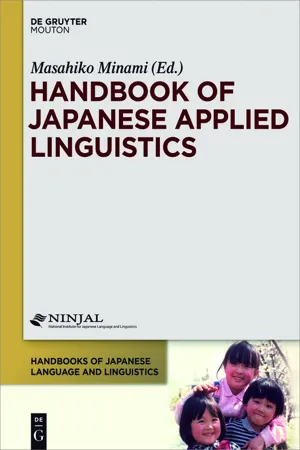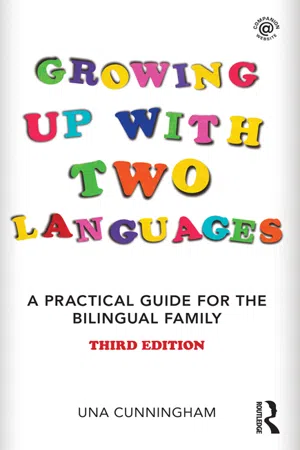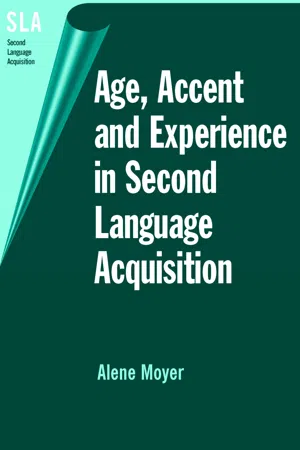Languages & Linguistics
Critical Period
A critical period refers to a specific time in an individual's development during which they are most receptive to acquiring certain skills or knowledge. In the context of language acquisition, it is believed that there is a critical period during childhood when individuals are most adept at learning languages, and that this ability diminishes with age. This concept has significant implications for language education and bilingualism.
Written by Perlego with AI-assistance
Related key terms
10 Key excerpts on "Critical Period"
- eBook - ePub
Tutorials in Bilingualism
Psycholinguistic Perspectives
- Annette M.B. de Groot, Judith F. Kroll(Authors)
- 2014(Publication Date)
- Psychology Press(Publisher)
Second Language AcquisitionPassage contains an image
CHAPTER ONE The Critical Period Hypothesis: Where Are We Now?Birgit Harley Wenxia Wang Ontario Institute for Studies in EducationThe idea that children have a special talent for languages that is rarely, if ever, available to older learners is one that has much popular support. Among second language researchers, however, the related hypothesis of a maturationally delimited Critical Period for language acquisition has been a constant source of controversy. Not everyone accepts the view that young children have an inborn advantage over older learners, and even among those who take this position, debate continues as to what the causes of this advantage are, what the relevant age limits are, what aspects of language development it applies to, and what sort of empirical data provide a crucial test of the Critical Period hypothesis. In this chapter, we review relevant research findings and consider various proposed explanations of age-related differences in (second) language acquisition. We argue that, despite a number of unresolved problems and even some apparent counterevidence, the Critical Period concept, as it has evolved, continues to have considerable heuristic value in investigating the language development of learners whose exposure to a new language begins at different ages.The Critical Period Concept
The Critical Period concept is a cross-disciplinary one that has been applied to various aspects of behavioral development in both animals and humans (e.g., Bornstein, 1987; Colombo, 1982; Immelmann & Suomi, 1981; Oyama, 1979). It refers to a period of time during the life cycle when there is greater sensitivity to certain types of environmental stimuli than at other times (Colombo, 1982), or "a period of competence for specific exchanges with the environment, bounded on both sides by states of lesser responsiveness" (Oyama, 1979, p. 88). A classic example is filial imprinting in birds. Lorenz (1937), for example, found that during a limited period soon after hatching, greylag goslings become irreversibly attached to the first moving object they see, this moving object normally being the parent. If exposure was delayed beyond a Critical Period lasting only a few days, the filial attachment was weaker or failed to occur. Time-constrained sensitivity to environmental stimuli has since been documented in many other animal species and developmental domains, including the learning of birdsongs, the development of vision in kittens and monkeys, and the social behavior of various species of mammals (e.g., Bornstein, 1987). As Lenneberg (1967), one of the first to apply the Critical Period concept to human language development,1 - eBook - ePub
Language Acquisition
The Age Factor
- David Singleton, Lisa Ryan(Authors)
- 2004(Publication Date)
- Multilingual Matters(Publisher)
Chapter 3
The Critical Period Hypothesis: L1-related Evidence
Introductory
The popularly held view that there is a ‘Critical Period’ for language development is not generally subjected to more than rather superficial scrutiny. Most adults simply take it for granted, for example, that children are of their nature equipped to learn a foreign language with much less effort and in a generally more competent manner than they themselves are able to manage. Introductory psychology texts often treat the matter in a similarly axiomatic fashion but endow the assumptions they make with scientific credentials by introducing concepts and terminology from such domains as neuropsychology and nativist linguistics. This is not to say that the Critical Period Hypothesis is without its critics. Indeed, the question of whether there is a Critical Period for language development has generated fierce debate among researchers and continues to do so. As was indicated in Chapter 1 , the discussion has both a theoretical and a practical dimension and is of interest to L1 acquisition researchers and L2 acquisition researchers alike. For some theoreticians the Critical Period Hypothesis is important because the notion of maturational constraints on language acquisition is seen as related to the idea that language development is underpinned by special bioprogramming. In the more practical sphere of language education, the Critical Period Hypothesis has ramifications with respect to decision-making about the starting point for the introduction of L2 instruction in schools. The L2 issues will be discussed in detail in Chapters 4 and 6 - ZhaoHong Han(Author)
- 2018(Publication Date)
- Multilingual Matters(Publisher)
Plasticity, in the eyes of many, is synonymous with sensitivity and flexibility. Scovel (1988), for example, defines it as the overall ability of the brain to program and process new patterns of behavior quickly and efficiently, and to relocate this ability to different areas of the brain should there be congenital damage or injury incurred after birth. High sensitivity to external stimuli is further correlated with success. Early learners are assumed to possess high sensitivity, and hence are successful in learning. Late learners (e.g., adults), on the other hand, have a lowered sensitivity – being less responsive to environmental influences such as input from the target language – and hence are less successful. As Eubank and Gregg (1999: 90) aptly put it, 'once the period is past, linguistic input ceases to have an instructional effect with regard to those aspects [of language]'. Of relevance to note, this proposition is consistent with findings from a number of recent neurophysiological experiments with early and late bilinguals that are conducted via Event-related Brain Potentials (ERPs), a technique for measuring electrical activity in different areas of the brain (see, e.g., Weber-Fox & Neville, 1999).Loss of plasticity, however, is only a partial explanation for the physical reality of a Critical Period. As mentioned earlier, the existence of a CP hinges largely on the interaction between the innate neural mechanisms and the environmental stimulation. As Colombo (1982: 261) defines it:A Critical Period is a time during the life span of an organism in which the organism may be affected by some exogenous influence to an extent beyond that observed at other times. Simply, the organism is more sensitive to environmental stimulation during a Critical Period than at other times during its life.In a similar vein, Eubank and Gregg (1999:67) assert:Connection between innate structure and peripheral stimulus is a necessary, albeit not sufficient, condition on CPs: CPs appear only where development of the mature state depends on a significant contribution of both the relevant neural architecture and peripheral exposure.In many ways, the innate structure and the environmental stimulation are like two sides of one coin, and the constraints on language learning as a result of passing the Critical Period derive from the functioning, not of either side, but of both sides, of the coin. Just as maturational changes in the neural architecture may result in varying degrees of sensitivity to external stimuli – during the Critical Period learning is susceptible to alteration by external influences (Eubank & Gregg, 1999) – the type of external stimuli available to learners during the Critical Period can have permanent effects on their subsequent language development (cf. Eubank & Gregg, 1999; Schachter, 1996a). These effects, as Scott (1962; cited in Colombo, 1982: 261) points out, may take two forms: they may trigger the course of further normal development or produce 'an irrevocable result not modifiable in subsequent development' (p. 957).- eBook - ePub
Mind, Brain, and Language
Multidisciplinary Perspectives
- Marie T. Banich, Molly Mack(Authors)
- 2003(Publication Date)
- Psychology Press(Publisher)
But what is most evident is that, due to the heterogeneity of its interpretations and the generality of its applications in language-acquisition studies, the critical-period concept needs clarification and the terms critical and sensitive period require modification, (See Bornstein, 1987, chap. 1, for an excellent account of the defining characteristics of such a period, and Moltz, 1973, for his distinction between a critical and optimal period, akin to the reformulated version proposed later in this chapter.) Proposed Revised Definition of the Critical/Sensitive Period. Many researchers have abandoned the term Critical Period in favor of the term sensitive period when referring to language acquisition, asserting that, when an age-based declination in linguistic ability occurs, the declination is gradual rather than sudden or abrupt, as would be suggested by the notion of a Critical Period. Yet one can simply change the size of the intervals on the x axis of a graph purporting to demonstrate the presence of a Critical Period (e.g., change the measurement of time from years to months or weeks) and render gradual what was previously sudden. That is, mere numerical manipulation can make what appears to be a Critical Period into a sensitive period, and vice versa. (Customarily, in graphic representations of critical or sensitive periods, time is represented on the x axis and values associated with a particular trait, physical feature, mental property, ability, or behavior are represented on the y axis.) It is thus proposed that the term critical be applied only to that time during which complete acquisition or normal development of a behavior, property, and so on occurs and that the term sensitive be applied to that time during which partial acquisition or development of a behavior, property, and so on remains possible—refected graphically as a linear departure from, then arrival at, asymptote as demonstrated in Fig. 12.6 - eBook - ePub
The Psychology of Language
From Data to Theory
- Trevor A. Harley(Author)
- 2013(Publication Date)
- Psychology Press(Publisher)
The Critical Period hypothesis of Lenneberg (1967) comprises two related ideas. The first idea is that certain biological events related to language development can only happen in an early Critical Period. In particular, hemispheric specialization takes place during the Critical Period, and during this time children possess a degree of flexibility that is lost when the Critical Period ends. The second component of the Critical Period hypothesis is that certain linguistic events must happen to the child during this period for development to proceed normally. Proponents of this hypothesis argue that language is acquired most efficiently during the Critical Period. The idea of a Critical Period for the development of particular processes is not unique to humans. Songbirds display hemispheric specialization in that only one hemisphere controls singing (Demers, 1988). Many birds such as the chaffinch are born with the rudiments of a song, but must be exposed to the male song of their species between the ages of 10 and 15 days in order to acquire it normally. Evidence for a Critical Period for human linguistic development comes from many sources. Many songbirds, such as the chaffinch, are born with the rudiments of a song, but must be exposed to the male song of their species between the ages of 10 and 15 days in order to acquire it normally. Evidence from the development of lateralization The structure of the brain is not completely fixed at birth. A considerable amount of development continues after birth and throughout childhood (and indeed perhaps in adolescence); this process of development is called maturation. Furthermore, the brain (primarily the cortex) shows some degree of plasticity, in the sense that after damage it can to some extent recover and reorganize, or can adapt in response to pronounced changes in input, even in adulthood - eBook - ePub
- Masahiko Minami(Author)
- 2016(Publication Date)
- De Gruyter Mouton(Publisher)
One source of such disagreements comes in conceptualizing the Critical Period itself. There is no consensus as to what the Critical Period means and what evidence should be presented to prove or disprove the CPH. The notion of a Critical Period originates from studies of animals’ instinctive behaviors. It refers to a designated developmental phase in which certain capabilities and behaviors of an organism have to be learned in order for them to become functional in the organism. Imprinting behaviors among geese and singing among some songbirds are frequently cited as examples of learning that takes place during a certain Critical Period. Importantly, in the study of animal behavior, Critical Periods are associated with an innate biological mechanism that is programmed as part of newborns’ survival; the behaviors/capabilities in question are no longer attainable once the designated Critical Period has passed (Singleton and Ryan 2004). When the notion of a Critical Period was first extended to human language acquisition, neurologists made claims based on their clinical observations. Penfield and Roberts (1959 : 237) suggested the existence of “a biological clock” in the brain for language learning that shuts down around the age of nine. Similarly, Lenneberg (1967), based on his clinical observations of aphasia patients, children with Down syndrome, and deaf children, formulated the Critical Period hypothesis (CPH), claiming that the window opens around at the age of two and closes with puberty, which, in his view, coincides with a loss of brain plasticity resulting from the completion of hemisphere lateralization. These earlier “neurological” explanations to support the Critical Period in language acquisition are not supported by more recent behavioral and neurological research - eBook - ePub
- François Grosjean, Ping Li(Authors)
- 2012(Publication Date)
- Wiley-Blackwell(Publisher)
Researchers and laymen alike are interested in second language acquisition for a variety of intellectual and pragmatic reasons. But anyone who has experience learning a second language will probably be struck by the apparent child-adult difference: while most children appear to be at ease acquiring multiple languages simultaneously or learning additional languages successively, adult learners appear to have significant difficulties, sometimes even with rudimentary aspects of new languages, after years of struggle. Such age-related differences in L2 learning have motivated researchers to look for explanations, and led to decades of intense debates on the cognitive and neural mechanisms of second language acquisition. 7.1.1 The Critical Period Hypothesis Perhaps no other domain in second language acquisition has generated so much public attention, debate, and controversy as the Critical Period hypothesis (CPH). Indeed, understanding of the Critical Period for language learning has been listed among the top 125 big science questions for the next quarter century in the 125th anniversary issue of Science (vol. 309, July 1, 2005). According to the original formulation of the CPH by Lenneberg (1967), the automatic acquisition of a language in the natural setting (e.g., from mere exposure to a given language) takes place only during a Critical Period (age 2 to puberty), after which language learning proceeds more slowly, and ultimately proves less successful (Lenneberg, 1967: see Long, 1990 for a review). Lenneberg linked this critical time window to constraints in brain development, and the endpoint of that period coincides with puberty, at which time, it was believed, brain lateralization is complete, that is, the language function is settled in the left hemisphere (for over 90% of people) - eBook - ePub
Growing Up with Two Languages
A Practical Guide for the Bilingual Family
- Una Cunningham(Author)
- 2011(Publication Date)
- Routledge(Publisher)
A motivated and/or talented learner may achieve near-native proficiency in the grammar, vocabulary and semantics of the target language, but only exceptional learners will ever come to sound native as well. Small children are able to learn to speak a second language without any trace of a foreign accent, just as they learned their first language. The reasons for this are not fully understood. One possible explanation is encompassed in the critical age or Critical Period hypothesis, which states that there is a period in a child’s development when language acquisition occurs with very little effort, and that after a certain age the brain is no longer able to learn language in this way. This is based on early theories concerning brain lateralisation and neural plasticity (Penfield 1965; Lenneberg 1967). There is no general agreement about what age this is, but puberty has been suggested as a likely candidate (Major 1990). The Critical Period hypothesis is not uncontroversial. It has been suggested that differences between child and adult learning patterns may be due to a number of uncontrollable social and cultural factors (Flege 1987). Thomas Scovel’s book A Time to Speak (1988) gives an excellent exposition of this topic. Scovel concludes that there is a Critical Period for pronunciation, but finds no evidence that the Critical Period hypothesis holds true for other aspects of second language learning. He suggests that there may be sociobiological reasons why accents solidify at puberty. It is at that time that other aspects of the individual’s perception of his or her own identity surface, and it is therefore appropriate that individuals are marked as belonging to a particular group just then. Major (1990) found evidence to suggest that it might not be possible for adults who have acquired only one language during the Critical Period and who have later been exposed to a second language to acquire or maintain native-like proficiency in pronunciation in both languages - María del Pilar García Mayo, María Luisa García Lecumberri(Authors)
- 2018(Publication Date)
- Multilingual Matters(Publisher)
Penfield's notion about the 'unphysiological' nature of later language learning was very much echoed in the work of Lenneberg, the person who is generally acknowledged as the 'father' of the Critical Period Hypothesis relative to language acquisition. Lenneberg saw the human capacity for language acquisition as constrained by a Critical Period beginning at age two and ending around puberty, this period coinciding with the lateralization process – the specialisation of the dominant hemisphere of the brain for language functions. He adduced a wide range of evidence pointing to changes in the brain that were occurring during this period. However, his claim that lateralisation ends at puberty has been significantly undermined by later studies which reinterpret the data in question as indicating that the process is already complete in early childhood (see, e.g., Kinsbourne & Hiscock, 1977; Krashen, 1973). Moreover, that part of Lenneberg's argument which referred to L2 learning, namely his suggestion that after puberty the learning of L2s required 'labored effort' and foreign accents could not be 'overcome easily' (Lenneberg, 1967: 176) was of dubious status in scientific terms. While his arguments in relation to the maturation of the brain development were supported with a range of neurological evidence (some of which has, as has been noted, since been reinterpreted), no evidence was offered in respect of his claims regarding post-pubertal L2 learning, which relied instead simply on an implicit appeal to popular assumptions.The Concept of Critical Period
Before we proceed further in our discussion of the Critical Period Hypothesis (henceforth CPH), it may be worth reminding ourselves how the concept of Critical Period is usually understood in the biological sciences. The example that is usually cited in this connection is that provided by Lorenz (1958), who noted that new-born goslings became irreversibly attached to the first moving object they perceived after hatching. Usually, the first moving object in question is the gosling's mother. However, any other moving object will trigger the relevant reaction if it comes into the gosling's line of vision in the post-hatching period. The period during which the attachment of this kind may be effected is limited in duration, and beyond that period the gosling will no longer fix its following behaviour in the way described. Indeed, when this particular period ends, goslings will retreat from rather than follow moving objects.- Alene Moyer(Author)
- 2018(Publication Date)
- Multilingual Matters(Publisher)
Chapter 1Contextualizing Critical Period Inquiry
Coming into contact with a foreign language means hardship whichusually brings euphoria quickly to an end, making it a short episode forthe individual - and also for groups and nations.Konrad Ehlich, 1994[A second] language emerges through necessity ... because I want it,urgently want it, and because I urgently attend to it.Peter Bichsel, 1995 [translation mine]The Problems of Scope and Classification
The field of second language acquisition (SLA) has long sought relevant factors to explain differential attainment for early and late learners. Since the appearance of Lenneberg’s Biological Foundations of Language (1967), the idea of a Critical Period for language learning has guided a great deal of the research on second language acquisition.1 Though Lenneberg made little specific mention of SLA, his Critical Period hypothesis has evolved into a full-blown theory for the field, often assumed to be a ‘unitary account of non-native like outcomes’ (Birdsong, 1999: 9). Still, the question remains why late language learners typically perform in notably ‘non-native’ ways. In the search for answers, we too rarely recognize the highly individual and complex nature of the endeavor. This is an especially salient issue given that SLA is most often an uninstructed, i.e. non-classroom, process among immigrants to foreign lands who face harsh social and economic conditions, possibly remaining culturally isolated for years.Given this context of great challenge, many fall far short of a native speaker ideal, while others succeed beyond all expectations. By all accounts, we cannot yet explain either extreme of the success scale: entrenched fossilization and exceptional learning. The empirical evidence points to no specific faculty or mechanism in either the neurological or cognitive realm to explain exceptional performance in L2 (Obler, 1989; Schneidermann, 1991 as cited in Birdsong & Molis, 2001). Why, then, do more learners not
Learn about this page
Index pages curate the most relevant extracts from our library of academic textbooks. They’ve been created using an in-house natural language model (NLM), each adding context and meaning to key research topics.
